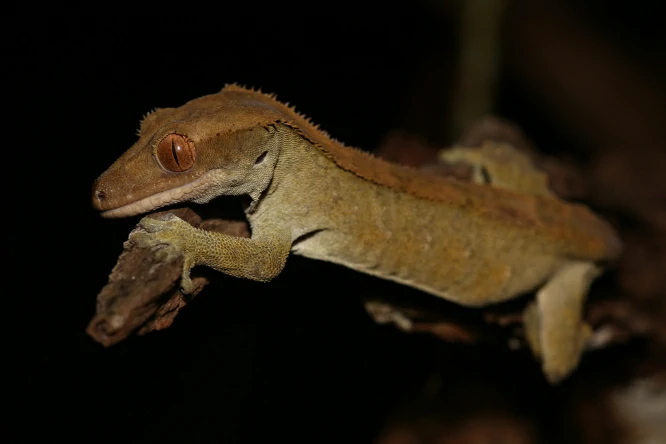You’ve probably seen a gecko resting perfectly still on a warm rock or tucked under a leaf at night. Its body looks motionless, but sometimes its eyelids twitch just a little. That tiny movement makes you wonder, do geckos dream?
Geckos probably have simple dreams, though not like human dreams. Their brains show sleep patterns that include active phases similar to REM sleep in mammals, the stage where dreaming happens. They likely don’t dream in stories or pictures like we do, but their brains may replay parts of their daily life, like hunting or avoiding predators.
How Geckos Sleep Differently From Humans
Most geckos don’t have eyelids like we do, except for a few species like the leopard gecko.
Most sleep with their eyes open, covered by a clear scale that keeps them moist and protected.
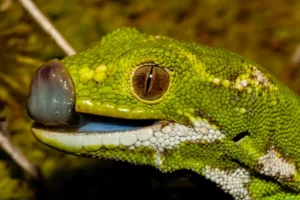
When they rest, their breathing and movement slow down, but they stay somewhat alert. This light sleep helps them stay ready for danger.
Still, geckos sometimes show signs of deeper rest. Their muscles relax, their heart rate slows, and they might twitch lightly.
That twitching is a clue, scientists often link it to dreaming in animals.
What Scientists Know About Reptile Sleep
For a long time, scientists thought reptiles had only one kind of sleep, slow, steady, and without dreaming. But new studies suggest that’s not true.
Research on Australian bearded dragons and anoles, lizards closely related to geckos, found two sleep states.
One looks like deep sleep, the other like REM sleep, where most dreams happen.
If other reptiles share this pattern, geckos probably do too, with short bursts of brain activity that could create simple dreams.
What Happens in a Gecko’s Brain During Sleep
When a gecko rests, its brain waves slow down. Then at certain moments, activity spikes for a few seconds. These bursts are like REM cycles.
During these times, the gecko may flick its eyes, twitch its tail, or move its toes slightly.
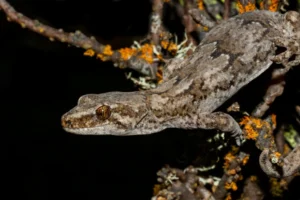
The brain seems to replay patterns from its waking life, movements, sounds, and shapes it has experienced.
In mammals, this stage helps build memory and triggers dreaming.
Geckos might not imagine stories, but they may relive little bits of their day in flashes of instinct.
How Dreaming Helps Geckos Survive
Dreaming might seem like something only emotional animals need, but reptiles could benefit too.
If geckos dream, it’s probably not about fantasy, it’s about practicing instincts.
A gecko might “rehearse” chasing an insect or avoiding danger through short memory loops.
Sleep becomes more than rest, it’s quiet practice. Each tiny replay could make them a bit sharper when they wake up.
When and How Long Geckos Sleep
Geckos are mostly nocturnal, meaning they’re active at night and sleep during the day.
You’ll often find them hidden in cool, dark spots, under bark, inside leaves, or behind rocks. Some species, like day geckos, do the opposite and sleep at night.
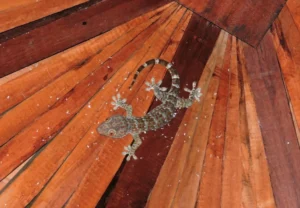
A typical gecko might sleep 10 to 12 hours, though it’s not deep, unbroken rest. They wake often to adjust position or check their surroundings.
Even during sleep, they stay sensitive to light, sound, and vibration.
How Geckos’ Environment Affects Their Sleep and Dreams
In the wild, a gecko’s rest depends on temperature, light, and safety. If it’s too cold, they move slowly and may sleep longer. If it’s hot or noisy, they stay alert.
This flexibility keeps them alive, but it also means their sleep cycles (and possible dreams) are short and scattered.
Pet geckos in steady temperatures and light cycles tend to have more regular sleep, which could make their dream-like phases happen more predictably.
Do Geckos Experience REM Sleep Like Humans?
Humans spend about 25% of sleep in REM, the dreaming phase. In reptiles, it’s much shorter, often under a minute per cycle. Still, the brain patterns are similar.
Repeated calm and active phases show that a gecko’s dream could be a brief flash of movement or memory, gone in seconds.
What a Gecko Might “See” in Its Dream
If geckos dream, their dreams probably aren’t pictures or voices. They might sense shapes, shadows, or quick movement, maybe the flicker of an insect’s wing or a leaf ripple.
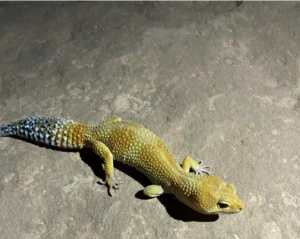
Their dreams could be silent rehearsals of what they do best: hunt, hide, and move with control.
Geckos don’t dream “stories”, they dream instincts.
Comparing Gecko Dreams to Other Reptiles
Other reptiles give clues about geckos. Bearded dragons have REM-like sleep every 80 seconds.
Green anoles show eye movement and brain bursts like active sleep.
Turtles and crocodiles also show alternating patterns, though less often.
Because geckos share much of the same brain structure, scientists think they likely share this basic dream-like activity.
Do Geckos Have Nightmares?
It’s unlikely geckos have nightmares like humans. They don’t process fear in the same emotional way.
Stressful experiences might still affect rest.
Loud noises, bright lights, or frequent handling could make them twitch more or sleep lightly.
That’s not a nightmare, it’s a reflexive stress response. Once the environment calms, their sleep returns to normal.
How Sleep Helps Geckos Remember and Learn
Even small reptiles can learn through repetition. Geckos remember hunting spots, hiding places, and territory layout.
Sleep, and possibly light dreaming, helps store these memories.
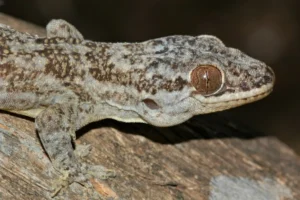
During active sleep, the brain might replay navigation or feeding sequences. These “memory rehearsals” are short but important.
They help geckos find food faster and avoid danger when awake.
Observing Gecko Sleep at Home
If you have a pet gecko, you can sometimes notice its sleeping habits.
During rest, it may stay still, or twitch subtly in its limbs or eyes. Those are tiny signs of active sleep.
You can help your gecko rest naturally by keeping:
-
A steady light-dark schedule
-
Quiet surroundings
-
Warm temperatures at night (for nocturnal species)
A calm, safe environment helps geckos cycle through rest naturally, and if they dream, that’s when it happens.
Can Geckos Sleep While Hanging on Walls?
Yes, they often do. Many arboreal geckos rest while clinging to vertical surfaces. Their toes grip easily thanks to tiny hairs called setae.
Their muscles lock gently, keeping them steady. Even during active sleep, those small twitches don’t make them fall.
Do Geckos Need Total Darkness to Dream?
Not always. Geckos’ eyes are very sensitive to low light. They can rest in dim settings without full darkness.
Bright light, though, can mess up their natural rhythm.
In captivity, a soft night light or turning lights off during rest helps them sleep properly.
How Long Gecko Dreams Might Last
A gecko’s “dream” might last only a few seconds. During that burst, the brain fires in patterns linked to movement and memory, then falls back into deep rest.
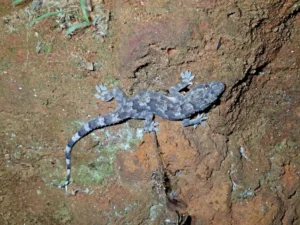
Over a day’s sleep, these bursts may happen dozens or hundreds of times, each a tiny flash of instinct, gone almost instantly.
Could Geckos Dream of Humans?
It’s unlikely. Geckos recognize movement, color, and patterns, but they don’t form emotional memories or symbolic images.
Their dream content focuses on instinctive cues: warmth, light, sound, and motion.
Your gecko might know your hand or voice when awake, but it probably doesn’t “see” you in its dreams.
Conclusion
Geckos probably do dream, though far simpler than ours. Their brains show active and restful sleep phases, suggesting short bursts of mental replay that help with memory and instinct.
They might not dream in pictures or feelings, but these rhythmic cycles show that sleep for them is more than rest, it helps them learn, survive, and stay sharp in a world full of movement.
Next time you see your gecko still, remember, behind those open eyes, there might be a flicker of a dream you’ll never see.
Hi, my name is Ezra Mushala, i have been interested animals all my life. I am the main author and editor here at snakeinformer.com.

